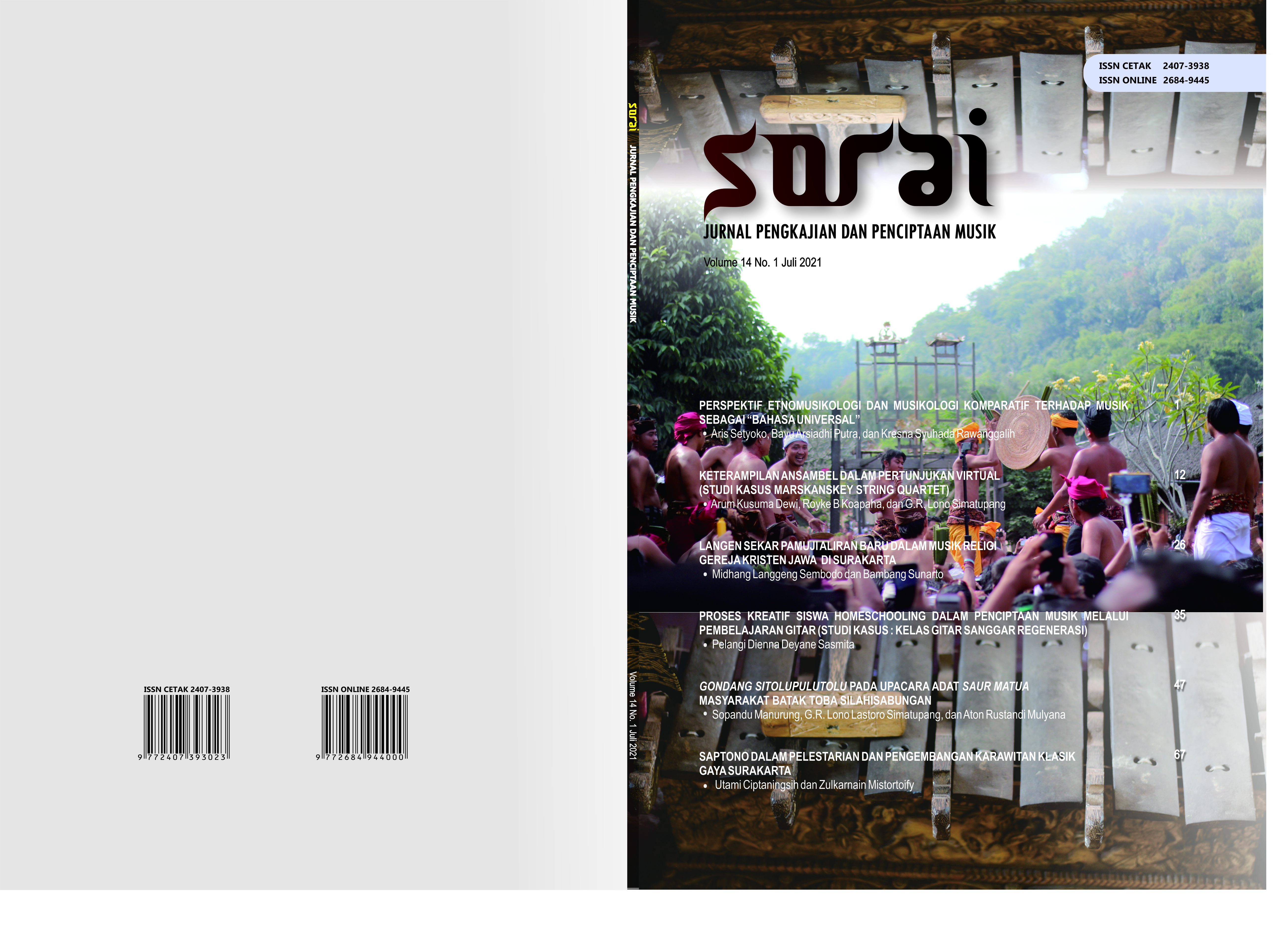KETERAMPILAN ANSAMBEL DALAM MUSIK KAMAR (STUDI KASUS MARSKANSKEY STRING QUARTET)
Main Article Content
Abstract
String Quartet is the most popular form of Chamber Music. In a string quartet there are no conductors as leaders, directors and music coordinators, no wonder many quartets end up disbanding due to problems. Marskanskey String Quartet is a group from Jogja that has been around for a long time and has more achievements, although based on initial observations this group looks the same as other groups. This research was appointed to find out what aspects of ensemble skills, how to apply ensemble skills in the Marskanskey group. To explore how the application of ensemble skills in the Marskanskey group, the author discusses the case with Keller's theory of ensemble skills. The author's theory considers that he is able to describe the discourse thoroughly, comprehensively and deeply, namely skills from the rehearsal process to performances. This research is a qualitative research with a case study approach. The results showed that Marskanskey had applied ensemble skills both in rehearsal and concert. With strategies in practice, including self-preparation until perfomances can influencing and supporting the success of a group to achieve maximum sound production. Interestingly, the researchers found a shift in function in the use of cues, as well as limitations in Keller's theory, namely the online cog-motor ensemble skill that occurs automatically.
Downloads
Article Details
Copyright
Authors who publish to Sorai: Jurnal Pengkajian dan Penciptaan Musik agrees to the following terms:
- Authors retain copyright and grant the journal right of first publication with the work simultaneously licensed under a Creative Commons Attribution License (CC BY-SA 4.0) that allows others to share the work with an acknowledgment of the work's authorship and initial publication in this journal.
- Authors can enter into separate, additional contractual arrangements for the non-exclusive distribution of the journal's published version of the work (e.g., post it to an institutional repository or edit it in a book), with an acknowledgment of its initial publication in this journal.
- Authors are permitted and encouraged to post their work online (e.g., in institutional repositories or on their website) before and during the submission process, as it can lead to productive exchanges, as well as earlier and greater citation of published work.
References
GAUNT, H. (2005). Becoming an Orchestral Musician:
A Guide for Aspiring Professionals
by Richard Davis. London: Giles de la
Mare Publishers Ltd., 2004. 236 pp,
99, paperback. British Journal of
Music Education, 22(3), 320–322.
h t t p s : / / d o i . o r g / 1 0 . 1 0 1 7 /
s0265051705246417
Thalib, S. B. (1997). PENDEKATAN
KUALITATIF DAN KUANTITATIF
DALAM PARADIGMA PENELITIAN
PERILAKU SIRI DAN KESEHATAN
MENTAL. Psikologika: Jurnal
Pemikiran Dan Penelitian Psikologi,
(7). https://doi.org/10.20885/
psikologika.vol3.iss7.art3
The Facts on File dictionary of music. (2004).
Choice Reviews Online, 42(02), 42–
–42–0654. https://doi.org/10.5860/
choice.42-0654
WILLIAMON, A. (2004). Strategies for ensemble
practice. In Musical
ExcellenceStrategies and Techniques to
Enhance Performance (pp. 105–122).
Oxford University Press. https://doi.org/
0 . 1 0 9 3 / a c p r o f : o s o /
003.0006
Creswell, J. W. (2014). Research Design
Pendekatan Kualitatif, Kuantitatif,
dan Mixed. Yogyakarta: Pustaka Pelajar
Moleong, L. J. (2021). Metodologi penelitian
kualitatif. PT Remaja Rosdakarya.
Sugiyono, D. (2013). Metode penelitian pendidikan
pendekatan kuantitatif, kualitatif dan
R&D.
Keller, P. E. (2014). Ensemble performance:
Interpersonal alignment of musical expression.
Expressiveness in Music Performance:
Empirical Approaches across
Styles and Cultures, January 2014, 260–
http://www.oxfordscholarship.com/
v i e w / 1 0 . 1 0 9 3 / a c p r o f : o s o /
001.0001/acprof-
Li, Z. (2018). String Quartet Ensemble T e c h -
niques Explained on the Basis of
the First Movement of Haydn ’ s
String Quartet in D minor , Op . 42.
Retoridka, R. B. (2016). Eksistensi D’Java String
Quartet Periode Tahun 2008-2015
(Sebuah Tinjauan Historis) (Doctoral
dissertation, Institut Seni Indonesia
Yogyakarta).
